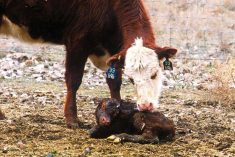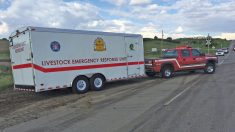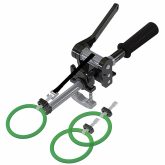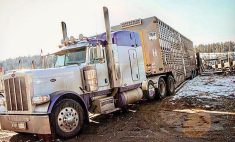Growing consumer interest in where and how livestock is raised is bringing animal welfare issues to the forefront in many different ways.
Explaining to non-farming residents and consumers the basics of proper livestock production practices is one part of the challenge, but also researching and adopting improved animal welfare practices is another important part of the job, say livestock specialists.
“There are more people on acreages and they may not come from a farming background,” says Lorna Baird, executive director of Alberta Farm Animal Care (AFAC), which operates a public ALERT line. “We’re getting more calls from interested people who want to know basically if what they’re seeing is a regular farming practice.”
Read Also

Harvest wraps up and fall work begins
At the Eppich famly ranch in western Saskatchewan, the fall harvest was successful with few breakdowns, cows and calves have been sorted and a new tractor has arrived
Last year the AFAC ALERT line received more than 500 calls, of which 88 cases relating to animal care were investigated and required some intervention either from the ALERT line resource team or the Society for the Prevention of Cruelty to Animals (SPCA) — the organization charged with enforcing the Animal Protection Act in Alberta.
“The ALERT line co-ordinator (who receives the call) will figure out if it’s an informational call, and the person wants to chat about regular farming practices, or if it’s something the industry should get involved in,” says Baird. Most calls are informational, which means the ALERT line also plays an important role in educating people about animal welfare.
“The example I like to use is in the winter if somebody sees horses in the field and they’ve got snow on their back,” says Baird. “They think that’s a bad thing and they must be uncomfortable and suffering, but really it’s a good layer of insulation. That’s what we would call an informational call.”
Informing and educating the public about animal welfare is increasingly becoming a priority for all involved in the livestock industry, as the public demands to know more about the products they see on their grocery shelves.
- From the Alberta Farmer Express: New animal welfare codes may only intensify scrutiny of livestock sector
New beef code
The new Beef Code of Practice released in September 2013 has several new requirements relating directly to animal welfare, which have also been influenced by public concerns.
“The Beef Code of Practice fits in to a bigger discussion about social licence and the way our industry is viewed by our peers and the public,” says Ryder Lee, manager of federal provincial relations for the Canadian Cattlemen’s Association (CCA). Lee presented details of the new code at the recent Manitoba Beef Producers (MBP) AGM in Brandon.
“The public allows us as an industry to continue doing what we do because we have a social licence; people accept that we raise animals where we do and how we do. This conversation is happening across the world.”
In drafting the code, four priority welfare areas were examined and reviewed by a scientific advisory committee. It reviewed research on painful procedures, feedlot health and morbidity, weaning methods and environmental and housing issues.
Painful procedures such as castration and dehorning are definitely a public concern. Effective January 2016 pain control will be required for dehorning of all animals and castration of beef cattle older than nine months must be done in consultation with a veterinarian. In January 2018, pain control will be required for castration of cattle over six months of age.
“From the public’s point of view painful procedures are a animal welfare priority issue,” says Lee. There is no doubt they are painful and there is no doubt we can do some things about them.” Lee is a member of the CCA Animal Care Committee and was involved in development of the new Beef Code of Practice.
Producers interested
Manitoba producers raised concerns at their AGM about the lack of products available for pain control. They were also concerned about the extra time and cost involved in administering them. “How long will I have to wait for the pain medication to take effect?” asked Don Guilford, a cattle producer from Clearwater, Man.
The best practice for castration is still to use the ring method and to do it as early as possible, says Dr. John Campbell of the Western College of Veterinary Medicine, who chaired the science advisory committee for the new Beef Code of Practice. He explained his experiences with dehorning. Campbell administers a drug to block animal pain, “as soon as they are restrained, do all their vaccines and then dehorn them, so maybe it has 30 seconds or a minute at the most to wait. I would say 95 per cent of the ones that I block don’t struggle at all — they don’t feel any pain,” he says.
“It’s amazing how quickly it does work and it’s not a hard thing to do. I could teach it to anybody in half an hour. But it does require Lidocaine, which your veterinarian doesn’t want to just give to someone without proper training.”
Campbell admits there aren’t many options available for local anaesthetics. Currently producers have the choice of an anaesthetic (such as Lidocaine) which blocks pain during the procedure but wears off after a couple of hours or an analgesic such as Metacam (Meloxicam), which helps control pain after the procedure for up to 24 hours. Both need to be prescribed by a veterinarian. Part of the new code requires producers develop and maintain a relationship with a veterinarian.
Campbell says there is research currently underway in Canada to look at developing new pain control products. There is also research into a possible vaccine against certain hormones that would stop testicular development.
If producers want to keep their social licence to produce beef, says Lee, they will need to get their own message across to consumers.
“The Canada Beef website is a great example of how the industry is doing a good job of providing people with information about beef and animal welfare,” says Lee. But not all information people find on the Internet is produced by Canada Beef. “They’ll find stuff on YouTube like the Meatrix,” he says. “And reality doesn’t necessarily interact with whether or not that social licence should be maintained.”
Retail leads the way
Lee says the retail industry is ahead of the curve in understanding consumer influence. Food safety and animal welfare issues have become part of corporate social responsibility platforms.
“It starts with sustainability and then they have intensified interest by their stakeholders — whether it’s their consumers, or activists — who pressure them to use their power on their supply chain to precipitate change and make sure things are done the way they think they should be done,” says Lee.
A & W recently launched a controversial “Better Beef” campaign claiming its beef has no added hormones or antibiotics. McDonald’s has already committed to 100 per cent Canadian beef for its hamburgers for all of its Canadian restaurants and the global company has announced it will begin purchasing verified sustainable beef by December 2016.
Producers have to be a part of the process of informing consumers they produce beef in a sustainable and ethical way, says Jeffrey Fitzpatrick-Stilwell, manager of sustainability for McDonald’s Canada, who also spoke at the MBP AGM.
“We understand from our customers, from government, and from NGOs what they want from us,” says Fitzpatrick-Stilwell. “They are very clear about what they want us to do and take action on. But the key point is we need to rely on producer expertise first and foremost. We’re not the experts on sustainable beef. It’s got to be producer-led from our perspective, so we need producers to tell us how best management practices work and why they are the best practices.”
Beef producer associations are among the many partners, which includes agri-industry companies, retailers, processors, NGOs and animal welfare and environmental groups participating in the Canadian and Global Round Tables on Sustainable Beef. That forum is trying to arrive at a definition of what sustainable beef is and develop guidelines for how it’s produced and verified.
Producer role
McDonald’s experience shows producers have a huge role to play and are extremely credible with consumers. During its “Our Food, Your Questions” campaign last year McDonald’s received thousands of questions about its food supported by unscripted videos, which was part of the campaign. One video featured Bob Lowe’s Alberta ranch showing how his cattle are raised and fed. It has gained thousands of views.
Fitzpatrick-Stilwell says the company has received a positive response from customers and others in the industry about its tray liner, which features CCA vice-president and cattle producer Dave Solverson.
“When they see a picture of a rancher standing on his farm, they know that’s where our beef comes from, that’s authentic and real to them and they are more trusting of that,” he says. “It’s much more credible to them.”
The beef industry continues to work to develop protocols and programs that can measurably demonstrate sustainability and good animal welfare practices to its customers, who are increasingly also its neighbours.
















